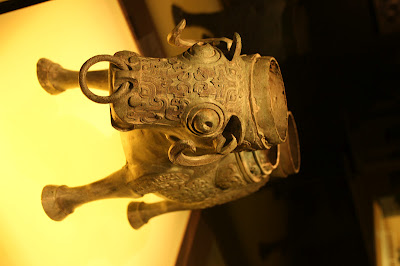 |
| Walking along the Great Wall of China- all will be revealed in my next blog! |
 |
| Just one of a million artefacts in the best museum in China |
 |
| The early coins on display at the Shanghai museum |
My Chinese journey began in Shanghai ( after an 18 hour train journey from Hong Kong where I slept most of the way as my bunk/ hard sleeper didn't allow me to sit up!)
China's largest city has a population of 23 million and it clearly typifies the contradictions of modern China. Glitzy department stores and skyscrapers on the one hand, poverty and prostitution on the other. China has the biggest gulf between rich and poor in the world.
Shanghai doesn't have the history of other Chinese cities but it's a great place to feel the pace of modern China. Even from my limited time in the city, wandering down East Nanjing Road with its big named stores- Cartier, Louis Vuitton, etc then turning into a side street where street vendors, local cafes and stalls selling anything and everything predominate. It really gave you a sense of East meets West, the modern and the ancient.
It's name means by the sea and as the gateway to the Yangzi river it was an ideal trading port. By the 1930s it was the busiest international port in Asia thanks to the British ( and later the French and Japanese). It was a city built on the trade of opium, tea and silk.
Shanghai's has both historical and contemporary importance. It was where the Chinese communist party was formed in 1921 and during the Cultural Revolution it was the power base of the 'Gang of Four'. Many of todays leaders hail from the city. Central government would love to see Shanghai viewed as the the leading city in China, rather than Hong Kong (as a former British colony).Time will tell..
So my introduction to China was in Shanghai. After finding my hostel ( the wonderful Blue Mountain Bund) with a little bit of help ( thank you to a lovely German guy who pointed me in the right direction as Chinese road signs are not always that helpful) ! I set about exploring the immediate area and was soon to discover what a great spot I was in. East Nanjing Road is at the end of the street- one way to People's Square, the other way the Bund. Two of the most important areas in Shanghai. One my first full day I headed to the Shanghai museum having heard that it is a must and you need at least half a day. It did not disappoint.
Established in 1952 it is a world famous showcase for Chinese art. It houses one million exhibits in sections including bronze, ceramics, paintings, calligraphy, jade and ivory.
I particularly loved the bronze and ceramics sections. As a history teacher I was aware that ancient Chinese civilisation was well ahead of its time but even so I was amazed at the craftsmanship of artefacts that were over a thousand and in some cases several thousand years old. I've included a tripod Ding (used for cooking) which weighs over 200 kg. It is extremely rare and suggests the power and influence of the nobility for whom it was created in the 11th century BC.
Another area of interest was the coinage system. China is known as the birth place for paper money but it's history of coins goes back before the 3rd century BC with its first cast coins followed by round coins with central holes from then on. It's first paper money was introduced from 960AD. (see pictures) .The ancient Silk Road coins help record the economic history of the ancient nations along the Silk Road.
I also visited the Propaganda Museum which showcased posters from the days from when the Republic was proclaimed up until the time of Mao's death. There were lots of posters in chronological order with
examples of utopian life and anti-capitalist anti Western sentiment as you would expect. Having studied some Chinese History, I could identify with the Cold War images of Mao alongside Stalin, Lenin and Marx, the importance of images in History never clearer.
 |
| One of the many images of Chairman Mao in the Propaganda Art Museum |
 |
| The views along the Bund. I'm sure they would be better if it wasn't raining! |
I wandered the area known as the French Concession where there was a real European vibe. Shanghai's reputation as the 'Paris of the East' evolved from here. Walking down the tree- lined streets with imposing European villas , you realised that this is certainly a chic area of town. I imagine in summer it would be wonderful here, with green on the trees and alfresco dining.
Another highlight was the Jade Buddha temple, Shanghai's most famous. Pyres were being lit and incense being burned, the importance of religion so obvious yet the atmosphere felt strangely at odds with the mass consumerism on the streets beyond.
I loved Shanghai- the hostel, atmosphere and simply experiencing the 'real' China only a few streets from the main shopping area and sights.
Next stop: Beijing
Shanghai on my list then...
ReplyDelete